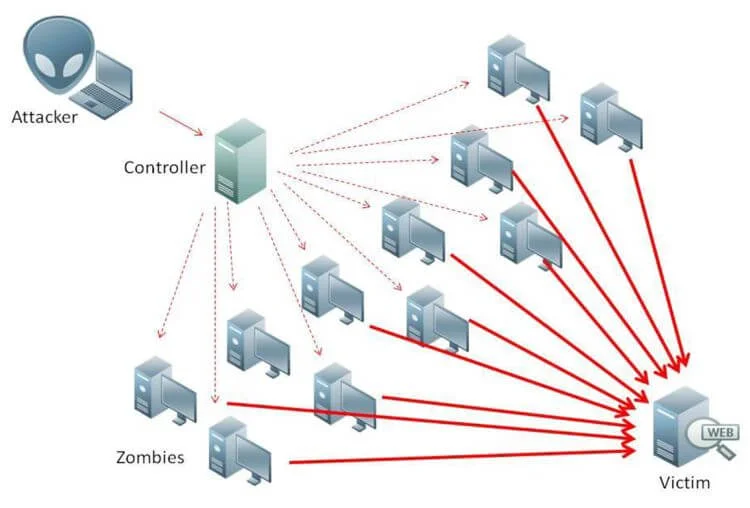Why DDoS Protection is Critical
Last Updated: March 23, 2020

Updated April 25, 2019
Distributed Denial-of-Service (DDoS) attacks are on the rise, and everyone has a target on their back. That’s why DDoS protection is no longer an option, but a necessity for anyone trying to prevent downtimes and other headaches – including a damaged reputation – that are associated with DDoS attacks. Nowadays web hosting must include DDoS protection, because it’s critical.
KnownHost includes FREE DDoS protection with all web hosting plans. Click here to find out more.
Find out if you are getting DDoSed with this helpful blog post.
DDoS
Simply put, a DDoS attack is an attempt to make a server (or website) unavailable by overwhelming it with traffic from numerous sources. The attack targets a broad range of critical resources from news websites to banks and poses an incredible challenge to ensuring people can access and publish important information. The DDoS attack isn’t however limited to banks and news sites alone; it can also target small businesses, individual websites, political platforms and so on. So technically, no one is immune to DDoS attacks.
How it Happens
Attackers take time to create networks of infected machines, called botnets, by spreading malicious software through websites, social media and emails. They then manipulate these machines virtually, without their owner’s knowledge or consent, and use them as an army to launch an attack against the target. Some botnets are hundreds, thousands or even millions of computers strong – an unprotected server stands no chance.
Botnets can produce massive floods of traffic to overwhelm a system. The floods can be produced in a range of ways, including having the machine send vast amounts of random data to consume the target’s bandwidth or send more connection requests than the target can handle.
Unfortunately, almost anyone can get their hands on DDoS-for-hire services through underground markets. Meaning, anyone can pay a small price to silence websites they disagree or are displeased with, or disrupt a company’s online operations.

Types of Attacks
Application Layer Attacks
Application Layer Attacks aim to exhaust the resources of the target and interfere with access to the server or website. Hackers fill the botnets with a complex request that overwhelms the target server as it tries to process the applications. The command might need large downloads or database access. If the target server receives numerous thousands or millions of such requests within a short time, it can be overwhelmed and either slow down or lock up completely.
Protocol Attacks
This type of attack is focused on the networking layer of the target server or website. Its focus is to overwhelm the table space at the firewall, central network services or load balancer that sends requests to the target. Generally, network service follows the first in first out (FIFO) command, where the computer processes the first request before it goes to the next one. In a DDoS attack, the queue becomes so large that the machine lacks the resources to handle the first request.
Volumetric Attacks
In this attack, the botnet is used to generate a considerable amount of traffic and block the works on the target – more of like an HTTP Flood attack, but with more exponential response component. Imagine having 20 people order 50 items from the same store at the same time. When such an attack is directed to a server, it increases the response size, and the traffic amount explodes and clogs up the target.

DDoS Today
A 2018 survey by Corero Network Security revealed that more than two-thirds of companies experience between 20-50 DDoS attacks attempts every month. According to 91% of the 327 security professionals surveyed, DDoS attacks can cost targets up to $50,000 in attack mitigation, lost business and lost productivity. 78% of them stated that the loss of customer confidence and trust were the most damaging effect of such attacks on business.
DDoS attacks can have an instant and damaging consequence on an organization’s bottom line, both with regards to mitigation costs and lost revenue. Although not all DDoS attacks will cost companies $50,000, having a system come to a halt can affect customer trust and confidence. It will also influence that ability of salespeople to bring in new clients in the increasingly competitive markets. The attacks result in lasting damage to the reputation of a company and could hurt the churn and corporate profits and customer loyalty.
Here is Why DDoS Protection is Critical
Attacks On the Rise
The US DDoS Prevention Survey by IDC Research link offline revealed that more than half of IT security decision-makers had been victims of DDoS attack as many as ten times in 2017. Of this number, 40% lasted for more than 10 hours. These results are in tandem with ATLAS findings, which highlight that there were 7.5 million distributed denial-of-service attacks in 2017 – a rate that’s rising at almost the same speed as internet traffic, according to Cisco.
The rapid growth can be attributed to three factors: motivation of attackers; accessibility of cheap attack services, and advancement in IoT botnets capabilities.

DDoS Attacks Evolving
Not only are more DDoS attacks being launched today, but the attackers are also uncovering new ways to integrate the latest technologies for large-scale attacks. In 2017, the attacks inclined towards big volumes attacks, but 2018 saw the highest level of attack ever recorded – the first terabyte per second frequency threat. In Q2 2018, there were 0.7% more attacks bigger than 300Gbps than in Q2 2017. And this is not about to slow down.
DDoS Disruption
As stated earlier, falling victim of these attacks can cost organizations up to $50,000, but the numbers could be more. Attackers are also starting to combine the attacks with other expensive illegal activity that can raise the recovery cost to include compulsory customer notification, breach reporting, and more complex recovery. According to a post on TechRepublic, 85% of security professionals said that these attacks are sometimes utilized as a distraction during a data breach activity, while 71% said their company experienced an attack that demanded a ransom.
Today’s DDoS attacks are increasingly multilayered and multivector, using a blend of massive volume attacks and stealth infiltration aiming the application later. This is the newest trend in an evolving landscape where perpetrators adapt their services and utilize advanced tools and abilities to try to evade and overcome existing defenses. Organizations need to maintain a consistent vigilance on the methods used to target their systems and constantly adjust their defenses as per the industry standards to stay safe.